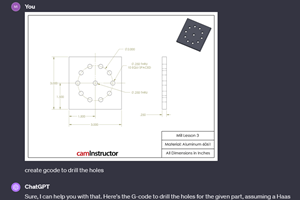NC Programming The Key To Cycle Time Reduction
This company focuses on up-front CAD/CAM programming to reduce cycle times, rather than machining optimization, with excellent results.
Share






Boyle Engineering focuses on up-front CAD/CAM programming to reduce cycle times, rather than machining optimization.
"I used to be very concerned about my machining cycle times, making sure everything was running as fast as possible," says Don Boyle. "Now I'm not that worried about that any more, because when a lot of new jobs are coming in, I can program them so fast in my software that it's taken the pressure off cycle-time reduction at the machine tool."
Mr. Boyle has realized a 50-75 percent reduction in programming time since purchasing AlphaCAM, a PC-based CAD/CAM system from Licom Systems, Inc. in Westborough, Massachusetts.
"Tool path is generated literally within seconds," Mr. Boyle says. "All I do is develop the graphics for the part--or use the system's CAD capabilities to clean up graphics already supplied to me--and the software will produce the cutter paths incredibly fast."
Boyle Engineering is located in Tyngsboro, Massachusetts. The 2000-sq.-ft. job shop specializes in microwave electronic products for the communications, defense and medical industries. On-time delivery is one of its customers' biggest requirements.
The company does close work--tolerances are typically ñ0.001-0.002". Most jobs are in aluminum; Boyle also works nonferrous and brass.
"Production runs are five to 500, with about 30 different orders a month," Mr. Boyle says. "That constant turnover means I have to get CNC programs written and to the machines quickly."
"With some of the other systems, you have to get three or four levels deep just to get to a routine, and there's a lot of information you have to remember. In AlphaCAM, the dialog boxes and the way the software is written are so clever that you can just step right through it, and within a short period of time, you're really producing programs."
Mr. Boyle runs the software on a 486 PC that clocks at 66 MHz and is equipped with 8 MB of RAM and a color monitor. CNC programs are downloaded directly from the PC to the vertical machining centers through an RS-232 port.
"Let's say I have a family of parts, or multiple parts I want to machine out of a single strip of stock," he says. "All I do is program one part, tell the system I want six of these spaced at such and such an interval, and presto, everything is output to the machine."
Cutter compensation is another feature he likes.
"One part requires us to machine 150 small connector holes in a variety of grid patterns," Mr. Boyle says. "The material is 40 percent glass-filled, and we use specially ground carbide tools to machine the 0.041-inch diameter blind holes, as well as 0.021-inch diameter holes that break through the bottom of the blind holes.
"With the cutter comp, I can keep the job moving, continually opening up the holes to the correct diameter and tolerance even as the carbide tooling wears quickly in the abrasive material."
"The system automatically gives me run times on all the parts I program," he says. "Complicated parts are especially difficult to quote; having the machining cycle time up-front means I can make an accurate quote."
Once Mr. Boyle has done all the NC programming, he simply moves the tool path instructions directly to the machine.
"AlphaCAM goes right to NC code, right into the G-codes that you output to the machine," he says. "The other systems all seem to have a `middleman' language--the cutter path goes to one language, then you have to post process that, then it goes into G-code and out to the machine. It's crazy to do that--it makes no sense."
Not when you're rushing to get work out the door.
The bottom line, according to Mr. Boyle?
". . . programming is the big tie-up in job-shop work--once you get that under control, you've got the edge."
He's seeing the result of that competitive advantage.
"AlphaCAM is helping our business grow," he says. "We'll get another vertical soon, and we'll be bringing on some new people." MMS
Related Content
How this Job Shop Grew Capacity Without Expanding Footprint
This shop relies on digital solutions to grow their manufacturing business. With this approach, W.A. Pfeiffer has achieved seamless end-to-end connectivity, shorter lead times and increased throughput.
Read MoreCan ChatGPT Create Usable G-Code Programs?
Since its debut in late 2022, ChatGPT has been used in many situations, from writing stories to writing code, including G-code. But is it useful to shops? We asked a CAM expert for his thoughts.
Read MoreBlueprints to Chips: CAD/CAM Tips and Tricks
This collection of articles delves into the latest CAD/CAM innovations, from AI-driven automation and optimized tool paths to the impact of digital twins and system requirements.
Read MoreLarge-Format Machining With Small Cutting Tools and Dynamic Motion
Napoleon Machine, a defense contractor that provides parts for the M1 Abrams tank, recently took advantage of a CAM feature that allowed the company to streamline its cutting strategies and program offline. Here’s how the shop cut cycle times nearly in half with its large-format five-axis machining operations.
Read MoreRead Next
Machine Shop MBA
Making Chips and Modern Machine Shop are teaming up for a new podcast series called Machine Shop MBA—designed to help manufacturers measure their success against the industry’s best. Through the lens of the Top Shops benchmarking program, the series explores the KPIs that set high-performing shops apart, from machine utilization and first-pass yield to employee engagement and revenue per employee.
Read MoreAMRs Are Moving Into Manufacturing: 4 Considerations for Implementation
AMRs can provide a flexible, easy-to-use automation platform so long as manufacturers choose a suitable task and prepare their facilities.
Read More




















